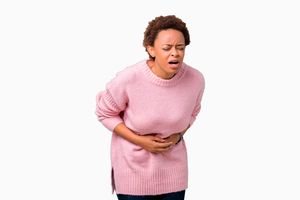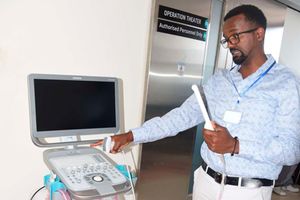My fibroid nightmare: Cocktails of painkillers do not take away my pain
What you need to know:
- Initially, a doctor who attended to her concluded that her appendix had a problem.
- Years later, a second doctor concluded that she had a bad case of hormonal imbalance.
- It's only a third doctor who correctly diagnosed the issue as fibroids.
- A scan of her uterus that was seen by the Nation showed that she has 8 fibroids.
For the past 15 years, Lucia Ayiela, 31, has lived with pain that sometimes leaves her bedridden for days. The last born in a family of four siblings became so fed up with the pain caused by fibroids that last week, she decided to take to social media to ask for the public's help in finding a permanent solution.
"Guys, I am looking for a gynaecologist who can offer pro bono services. Sis can't afford the fees and these fibroids have brought me down. Please re-tweet, my saviour could be on your timeline," she posted on her Twitter handle.
But long before she knew what was causing her pain, she had been misdiagnosed twice.
"In 2008, I started experiencing a stabbing pain on the right side of my abdomen that lasted about two days every month. The pain made it painful to walk. Sometimes it would come with a fever," she told Nation.Africa in an interview yesterday.
"My mother first took me to a private hospital for a check-up and the doctor who attended to me concluded that it was my appendix. That was my first misdiagnosis," she adds.
The doctor then backed up his "findings" with an abdominal scan, which showed that nothing was wrong with Ms Ayiela, but also told her that she was one of the few women who experienced what he described as ovulation pain.
"He advised me to take painkillers for my menstrual cramps because that too was considered "normal". And since he was the expert, I accepted and religiously took painkillers every time I had cramps."
But as the digital content creator got older, the pain in her pelvic region got worse and worse.
"In 2011, I went to see a doctor at the campus hospital because my cramps were making it impossible to attend lectures despite taking painkillers. This time, I was told that I had a bad case of hormonal imbalance and that they would put me on birth control pills to balance my hormones," says Ms Ayiela of her second misdiagnosis.
“That wasn't an option I was comfortable with, so the doctors recommended a cocktail of pain killers as the alternative to balancing my hormones through birth control pills.”
Got worse
When Covid-19 came in 2020, she says the quality of her life got worse.
“I would have random cramps even on days when I wasn't on my period with constant spotting around my ovulation days. Yet again, I decided to visit another gynaecologist. After a series of thorough tests, I found out that I been grappling with uterine fibroids all along.”
According to Dr Godfrey Mutakha, a consultant obstetrician and gynaecologist based in Eldoret, fibroids are growths of the uterus and are also called uterine leiomyomas or myomas.
"The uterus is made of muscle and fibroids grow from the muscle. Fibroids can grow from inside or outside the uterus. Fibroids are not cancerous and are not thought to be able to become cancerous. However, it can sometimes be difficult to determine whether a mass in the uterus is a common fibroid or a rare cancerous tumour," the expert points out in an interview with the Nation.
Although very common, Dr Mutakha explains that about 80 per cent of women will have fibroids in their lifetime, although not everyone will experience bothersome symptoms.
"Treatment is available for fibroid-related problems such as heavy menstrual bleeding, pain or pressure in the pelvis, or problems with pregnancy or infertility. For reasons that experts do not fully understand, fibroids are more common, more severe and occur at an earlier age in people of African descent".
Ms Ayiela was shocked, the kind of shock that is quickly followed by shame.
"I felt broken and almost damaged because as a woman I thought that having problems with my reproductive system made me incomplete. My gynaecologist was really good and she explained that what I was going through was something that a lot of black women go through. I was put on medication for a period of 30 days because at that point the fibroids were not big enough to warrant removal.
Range in size
Dr Mutakha explains that fibroids can range in size from microscopic to the size of a grapefruit or even larger. He points out that the majority of fibroids are small and do not cause any symptoms.
"However, some people with fibroids have very heavy or long menstrual periods (more than eight days a month), or pelvic pressure or pain that affects their lives.
Fibroids are more likely to cause symptoms if the fibroids are large, if there are many fibroids, or if the fibroid is located in certain places in the uterus,” he says while adding that fibroid symptoms tend to get better when a person stops having menstrual periods (menopause).
Ms Ayiela says her cramps are a painful three-day experience where she absolutely cannot function normally.
“It's starts with excessive bloating that slowly graduates into a mild uncomfortable feeling. In a few hours, it becomes full blown cramps that make the rest of my body super painful,” she says.
Lately, she says, she gets nausea and fever alomg with the cramps.
“The other day when my period started I was with my boyfriend. I remember curling up into the fetal position and crying. I had never wanted him to see me like this. He was shocked to say the least...he couldn't even hold me,” Ms Ayiela narrates.
On pelvic pressure and pain, Dr Mutakha told the Nation that larger fibroids can cause a feeling of pelvic pressure or fullness in the abdomen, similar to the feeling of being pregnant, and sometimes the presence of fibroids can even make a person look pregnant when they are not.
"If your fibroids are not causing any bothersome symptoms, you may decide not to have treatment. If you do have symptoms, your options include medication or surgery. The best treatment will depend on which symptom you are most bothered by and the size, number and location of the fibroids. Whether or not you want to get pregnant in the future is also a factor in most treatment decisions," he says.
Despite having a range of treatment options, Ms Ayiela says many of the hospitals she has visited do not accept the National Hospital Insurance Fund (NHIF) card, while the few that do tell her they do not have the qualified specialist to handle her case.
"Ideally, I should go for annual check-ups to monitor the growth of the fibroids, but as we all know, healthcare is quite expensive, especially if you do not have a steady source of income. A lot of hospitals do not accept an NHIF card and the ones that do will tell you that they do not have the qualified specialist to deal with your case, they will recommend a private facility which will cost a lot."
Ms Ayiela has urged the government to focus on creating awareness about sexual and reproductive health.
"There are many myths, misconceptions and misinformation around sexual reproductive health conditions that stigmatise and shame women for going through natural, biological body challenges. We need to stop normalising period pain. Our little girls should not grow up thinking that cramps are normal," she says, reminding us that pain in the human body is a sign that something is wrong.





